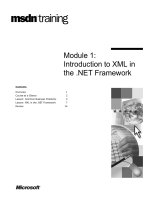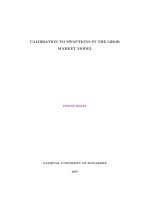Introduction to management in the hospitality industry
Bạn đang xem bản rút gọn của tài liệu. Xem và tải ngay bản đầy đủ của tài liệu tại đây (26.11 MB, 748 trang )
This page intentionally left blank
I N T R O D U CT I O N TO
M A N A G E M E N T I N TH E
H O S PITALITY I N D U STRY
FFIRS.indd i
23/12/10 7:28 PM
This page intentionally left blank
I N T R O D U CT I O N TO
M A N A G E M E N T IN THE
H O S PITALITY I N D U STRY
Tenth Edition
C L AY TO N W. B A R R O W S
TO M P O W E R S
D E N N I S R EYN O L D S
Chair and Professor
Whittemore School of Business
and Economics
University of New Hampshire
Professor Emeritus
School of Hospitality and
Tourism Management
University of Guelph
Ivar Haglund
Distinguished Professor
School of Hospitality Business
Management
Washington State
University
John Wiley & Sons, Inc.
FFIRS.indd iii
23/12/10 7:28 PM
This book is printed on acid-free paper.
Copyright © 2012, 2009, 2006 by John Wiley & Sons, Inc. All rights reserved.
Published by John Wiley & Sons, Inc., Hoboken, New Jersey.
Published simultaneously in Canada.
No part of this publication may be reproduced, stored in a retrieval system, or transmitted in any
form or by any means, electronic, mechanical, photocopying, recording, scanning, or otherwise,
except as permitted under Section 107 or 108 of the 1976 United States Copyright Act, without
either the prior written permission of the Publisher, or authorization through payment of the
appropriate per-copy fee to the Copyright Clearance Center, Inc., 222 Rosewood Drive, Danvers,
MA 01923, 978-750-8400, fax 978-646-8600, or on the web at www.copyright.com. Requests to the
Publisher for permission should be addressed to the Permissions Department, John Wiley & Sons,
Inc., 111 River Street, Hoboken, NJ 07030, 201-748-6011, fax 201-748-6008, or online at http://www
.wiley.com/go/permissions.
Limit of Liability/Disclaimer of Warranty: While the publisher and author have used their best
efforts in preparing this book, they make no representations or warranties with respect to the
accuracy or completeness of the contents of this book and specifically disclaim any implied
warranties of merchantability or fitness for a particular purpose. No warranty may be created or
extended by sales representatives or written sales materials. The advice and strategies contained
herein may not be suitable for your situation. You should consult with a professional where
appropriate. Neither the publisher nor author shall be liable for any loss of profit or any other commercial damages, including but not limited to special, incidental, consequential, or other damages.
Evaluation copies are provided to qualified academics and professionals for review purposes
only, for use in their courses during the next academic year. These copies are licensed and may
not be sold or transferred to a third party. Upon completion of the review period, please return
the evaluation copy to Wiley. Return instructions and a free of charge shipping label are available at www.wiley.com/go/returnlabel. Outside of the United States, please contact your local
representative.
For general information on our other products and services, or technical support, please contact
our Customer Care Department within the United States at 800-762-2974, outside the United States
at 317-572-3993 or fax 317-572-4002.
Wiley also publishes its books in a variety of electronic formats. Some content that appears in
print may not be available in electronic books. For more information about Wiley products, visit
our Web site at .
Library of Congress Cataloging-in-Publication Data
ISBN: 978-0-470-39974-3
Printed in the United States of America
10 9 8 7 6 5 4 3 2 1
FFIRS.indd iv
23/12/10 7:28 PM
CONTENTS
Preface
xix
P A R T O N E : P E R S P E C T I V E S O N C A R E E R S I N H O S P I TA L I T Y
1
CHAPTER 1
THE HOSPITALITY INDUSTRY AND YOU
What Is Hospitality Management?
2
4
Case History 1.1: A Former Student’s Unexpected Change
5
The Manager’s Role in the Hospitality Industry
5
Why Study in a Hospitality Management Program?
7
Employment Opportunities
Planning a Career
10
The Meaning of Work
Employment as an Important Part of Your Education
Profiting from Work Experience
12
■ Learning Strategies for Work Experience
Getting a Job
Getting in the Door ■ Learning on the Job
Profiting from a Job
16
■ Other Ways of
Industry Practice Note 1.1: An Employer’s View of Job Placement—Hyatt
18
Employment at Graduation
20
Global Hospitality Note 1.1: Career Opportunities Overseas
21
Goals and Objectives: The Strategy of Job Placement
22
The Outlook for Hospitality
25
The Effects of September 11, 2001 ■ Polarization in Hospitality Service
Organizations ■ Accelerating Competition ■ Service Is the Difference ■ Value
Consciousness ■ Technology ■ Empowerment ■ Diversity ■ Concern
with Security ■ Concern with Food Safety and Sanitation ■ Sustainability
Industry Practice Note 1.2: Leading the Charge in Going
Green—Orchard Hotels
30
Globalization
32
vi
CHAPTER 2
Contents
Summary
33
Key Words and Concepts
33
Review Questions
33
Internet Exercises
34
Notes
35
FORCES AFFECTING GROWTH A N D C H A N G E I N
T H E HOSPITALITY INDUSTRY
Managing Change
Demand
36
38
38
The Changing Age Composition of Our Population
Industry Practice Note 2.1: Demographics in Practice
41
Diversity and Cultural Change
Global Hospitality Note 2.1: As North America Ages, Some
Parts of the World Are Getting Younger
45
Industry Practice Note 2.2: Advocacy for the Advancement
of Women in Food Service
49
Industry Practice Note 2.3: Is the Middle Class Shrinking?
52
Supply
54
Land and Its Produce
■ Labor
Workforce Diversity
58
The Impact of Labor Scarcity
59
Summary
60
Key Words and Concepts
61
Review Questions
62
Internet Exercises
62
Notes
64
PA RT T W O: F O O D S E R V I C E
CHAPTER 3
THE RESTAURANT BUSINESS
The Varied Field of Food Service
The Outlook for Food Service
65
66
68
Contents
vii
The Restaurant Business
72
The Dining Market and the Eating Market
73
Dining Well
■ The Eating Market and Its Dynamics
Contemporary Popular-Priced Restaurants
80
Quick-Service Restaurants
Industry Practice Note 3.1: Subway and Enterpreneurship
Fast-Casual Restaurants
84
■ Midscale Restaurants ■ Casual Restaurants
Case History 3.1: Quark’s Restaurant Serves Earthlings Too
98
High-Check-Average Restaurants
Global Hospitality Note 3.1: Culinary Preparation
100
Restaurants as Part of a Larger Business
100
Restaurants in Retail Stores
CHAPTER 4
■ Restaurants in Shopping Malls
Summary
102
Key Words and Concepts
103
Review Questions
103
Internet Exercises
104
Notes
105
RESTAURANT OPERATIONS
Restaurant Operations
106
108
The Front of the House
■ The Back of the House
Industry Practice Note 4.1: Research Chefs Association
The “Office” ■
General Management
Making a Profit in Food Service Operations
Increasing Sales
121
■ Reducing Costs
Keeping the Score in Operations: Accounting Statements and Operating Ratios
Cost of Sales
116
124
■ Controllable Expenses ■ Capital Costs
Life in the Restaurant Business
128
Salary Levels
Summary
129
Key Words and Concepts
129
Review Questions
130
Internet Exercises
130
Notes
131
viii
Contents
CHAPTER 5
RESTAURANT INDUSTRY ORGANIZATION: CHAIN, INDEPENDENT,
OR FRANCHISE?
Chain Restaurant Systems
132
134
Marketing and Brand Recognition ■ Site Selection Expertise ■ Access to
Capital ■ Purchasing Economies ■ Control and Information Systems
■ New Product Development ■ Human Resource Program
Development ■ Chains’ Market Share
Independent Restaurants
142
Operating Advantages ■ Marketing and Brand Recognition
Selection ■ Access to Capital
■ Site
Industry Practice Note 5.1: Working with the SBA
145
Industry Practice Note 5.2: Why Go Public?
146
Purchasing Economies ■ Control and Information Systems ■ Human
Resources ■ The Independent’s Extra: Flexibility ■ The Independent’s
Imperative: Differentiation ■ Between Independent and Chain
Franchised Restaurants
The New Franchisee
151
■ Continuing Franchise Services
Industry Practice Note 5.3: Interested in Becoming a Franchisee?
The Franchisee’s View
155
■ The Franchisor’s View
Industry Practice Note 5.4: Rosenberg International
Center of Franchising
Franchisor-Franchisee Relations
CHAPTER 6
161
■ Franchising: A Middle Way
Summary
163
Key Words and Concepts
163
Review Questions
164
Internet Exercises
164
Notes
166
COMPETITIVE FORCES IN FOOD SERVICE
Competitive Conditions in Food Service
The Marketing Mix
168
169
172
Product
Case History 6.1: Finding the Proper Marketing Mix—Shakey’s Pizza
Price ■
Place–and Places
173
■ Promotion
Industry Practice Note 6.1: The Wealthiest Consumers
183
Contents
Competition with Other Industries
Convenience Stores
CHAPTER 7
ix
186
■ Supermarkets ■ The Home as Competition
Summary
190
Key Words and Concepts
191
Review Questions
191
Internet Exercises
191
Notes
193
ON-SITE FOOD SERVICE
Comparing On-Site and Commercial Food Services
194
196
Global Hospitality Note 7.1: International Perspectives
199
Self-Operated Facilities
199
Managed-Services Companies
200
Pros and Cons of Managed Services
Business and Industry Food Service
202
Industry Practice Note 7.1: Measuring Guest Participation
205
College and University Food Service
206
College Students as Customers
Health Care Food Service
210
The Dietetic Professional ■ The Dietetic Technician ■ The Dietary
Manager ■ Health-Care Food Service Department Organization
■ Trends in Health Care Food Service
School and Community Food Service
217
The School Food Service Model ■ Contract Companies in
School Food Service ■ Trends in School Food Service ■ Service
Programs for the Aging ■ Community-Based Services ■ Senior Living
Centers and Communities
Other Segments
Recreation
226
■ Correctional Facilities ■ Private Clubs ■ Transportation
Vending
229
Summary
232
Key Words and Concepts
233
Review Questions
233
Internet Exercises
234
Notes
236
x
Contents
CHAPTER 8
ISSUES FACING FOOD SERVICE
Consumer Concerns
Health and Wellness
238
239
■ Fast Food and a Hectic Pace ■ Nutritional Labeling
Industry Practice Note 8.1: Defining Health Claims
Food Safety and Sanitation
247
■ Alcohol and Dining
Food Service and the Environment
Thinking About Garbage from Dump to Waste Stream
Restaurant Industry
252
■ The Greening of the
Technology
Enhancing Customer Service
259
■ Technology in the Back of the House
Industry Practice Note 8.2: ESP Systems
Technology, the Internet, and Food Service Marketing
Management
262
■ Technology and
Summary
265
Key Words and Concepts
266
Review Questions
267
Internet Exercises
267
Notes
270
PA RT TH R E E: LO D G I N G
CHAPTER 9
271
LODGING: MEETING GUEST NEEDS
The Evolution of Lodging
The History of Lodging ■ The Evolution of the Motel
272
274
■ The Motor Hotel
Industry Practice Note 9.1: Europe: A Continent of
Lodging Distinctiveness
277
Classifications of Hotel Properties
278
Hotels Classified by Price ■ Hotels Classified by Function ■
Classified by Location ■ Hotels Classified by Market Segment
Industry Practice Note 9.2: Trends in Spa Operations
Hotels
286
Other Hotel Classifications
Types of Travelers
Business Travelers ■ Other Segments
International Travelers
289
Contents
xi
Anticipating Guest Needs in Providing Hospitality Service
292
Industry Practice Note 9.3: Creativity Is Evident in Hotel Properties
293
Industry Practice Note 9.4: The Hotel of the “Not So Distant” Future
295
Service, Service, Service
296
Employees as the Internal Customers
Industry Practice Note 9.5: Hotel Rating Services
298
Summary
303
Key Words and Concepts
305
Review Questions
305
Internet Exercises
306
Notes
307
CHAPTER 10 HOTEL AND LODGING OPERATIONS
Major Functional Departments
The Rooms Side of the House
The Front Office ■ Automation of the Front Office
Management ■ Housekeeping
310
312
314
■ Reservations and Yield
Industry Practice Note 10.1: Housekeeping
Telecommunications
324
■ Uniformed Services Staff
Industry Practice Note 10.2: The Concierge
327
Security
Hotel Food and Beverage Operations
Banquets ■ Food Production
■ Leased Restaurants
330
■ Sanitation and Utility
Industry Practice Note 10.3: Pros and Cons of Outsourcing
Food and Beverage Operations
335
Staff and Support Departments
335
Sales and Marketing
■ Accounting ■ Human Resources ■ Engineering
Income and Expense Patterns and Control
339
The Uniform System of Accounts
Entry Ports and Careers
Front Office ■ Accounting ■ Sales and Marketing
Beverage ■ Owning Your Own Hotel
342
■ Food and
xii
Contents
Summary
345
Key Words and Concepts
346
Review Questions
346
Internet Exercises
347
Notes
348
CHAPTER 11 FORCES SHAPING THE HOTEL BUSINESS
The Economics of the Hotel Business
A Cyclical Business
■ Hotel Cycles and Financial Performance
Industry Practice Note 11.1: Hotel Operations after Katrina
RevPAR
350
352
357
■ Hotels as Real Estate ■ International Hotel Development
Industry Practice Note 11.2: Condo-Hotels as Mixed-Use Developments
363
Industry Practice Note 11.3: The Elements of the Hotel Real Estate Deal
364
Private Equity Investments ■ The Securitization of the Hotel Industry ■ The
Hazards of Public Ownership
Dimensions of the Hotel Investment Decision
371
Case History 11.1: Going Public: Some Good News and Some Bad
372
Financial ■ An Operating Business ■ Segmentation: For Guests or
Developers? ■ Management Companies ■ Asset
Management ■ Entrepreneurial Opportunities
Summary
379
Key Words and Concepts
380
Review Questions
380
Internet Exercises
381
Notes
383
CHAPTER 12 COMPETITION IN THE LODGING BUSINESS
The Conditions of Competition
386
388
A Fragmented Market ■ A Cyclical Market ■ Cost
Structure ■ Securitization ■ Technological Revolution
The Marketing Mix in Lodging
391
Competitive Tactics
Product in a Segmented Market
Food Service
■ Other Services and Amenities
393
xiii
Contents
Systemwide Services
Industry Practice Note 12.1: Hotels Honored among World
Business Hotels
403
Industry Practice Note 12.2: Franchisors-Franchisees: A Growing
Team Approach
405
Price and Pricing Tactics
406
Yield Management
Place—and Places
Location
410
■ Distribution Channels
Industry Practice Note 12.3: Travel Intermediaries: Utell
Hotels and Resorts
412
Promotion: Marketing Communication
416
Advertising in Mass Media ■ Advertising on the Internet ■
Sales Promotion
Summary
420
Key Words and Concepts
421
Review Questions
421
Internet Exercises
422
Notes
423
PA RT F O U R: TR AV E L A N D TO U R I S M
42 5
CHAPTER 13 TOURISM: FRONT AND CENTER
The Importance of Tourism
Factors Affecting Travel and Tourism
Travel
426
427
■ Income Trends ■ Demographics and
Travel Trends
431
Global Hospitality Note 13.1: Public Anxiety and the Travel Industry
432
Mode of Travel
■ Trip Duration
The Economic Significance of Tourism
435
Tourism and Employment ■ Publicity as an Economic Benefit
The United States as an International Tourist Attraction
Measuring the Volume
438
■ Reasons for Growth of the United States as a Destination
Businesses Serving the Traveler
Passenger Transportation
■ Channels of Distribution ■ Reservation Networks
440
xiv
Contents
Noneconomic Effects of Tourism
Crowding
448
■ Favorable Noneconomic Effects
Global Hospitality Note 13.2: Volunteer Tourism—or Voluntourism
452
Summary
453
Key Words and Concepts
454
Review Questions
454
Internet Exercises
455
Notes
457
CHAPTER 14 DESTINATIONS: TOURISM GENERATORS
Motives and Destinations
Mass-Market Tourism
Planned Play Environments
Theme Parks
Cities
458
460
464
465
■ Themes ■ Scale ■ Regional Theme Parks ■ Themes and
Industry Practice Note 14.1: A Different Kind of Theme Park
Employment and Training Opportunities ■ Casinos and Gaming
Vegas ■ Atlantic City ■ Mississippi Gulf Coast
472
■ Las
Case History 14.1: Changes Come to Atlantic City
486
Other Markets ■ Casino Markets and the
Business of Casinos ■ Casino Staffing
Urban Entertainment Centers
490
Case History 14.2: The National Restaurant Association Restaurant Show
492
Shopping Centers ■
Zoos, Sanctuaries, and Aquariums
Temporary Attractions: Fairs and Festivals
497
Case History 14.3: The New Orleans Jazz Fest
499
Natural Environments
500
On a Lighter Note
503
Summary
504
Key Words and Concepts
504
Review Questions
505
Internet Exercises
505
Notes
508
Contents
P A R T F I V E : M A N A G E M E N T I N T H E H O S P I TA L I T Y I N D U S T R Y
CHAPTER 15 MANAGEMENT: A NEW WAY OF THINKING
Management and Supervision
The Economizing Society
The Managerial Revolution
xv
509
510
512
513
514
Taylor: The Work Process Focus ■ Fayol: Administrative Management
■ Human Relations: Work as a Social Process ■ Implications for the
Modern Hospitality Manager
Management: A Dynamic Force in a Changing Industry
520
Statler: The First “National” Hospitality System ■ Stouffer’s Modern
Management Techniques ■ The Building of Complex Hospitality Systems
Case History 15.1: Where Does a Concept Come From?
527
What Is Management?
528
What Is Our Business?
■ In Business for Yourself?
Summary
535
Key Words and Concepts
535
Review Questions
536
Internet Exercises
536
Notes
537
CHAPTER 16 PLANNING IN HOSPITALITY MANAGEMENT
Why Study Planning?
Planning in Organizations
Case History 16.1: Planning on an Olympic Scale at ARAMARK
538
540
541
542
Some Planning Concepts
Goal Setting
545
Characteristics of Well-Thought-Out Goals
■ Goals and Policies
■ Goal Congruence
Planning in Operations
Strategic Issues
549
■ From Strategy to Tactics
The Individual Worker as Planner
553
Planning as a Personal Process
Long-Range Planning Tools
Return on Investment
■ Cost-Benefit Analysis
554
xvi
Contents
Summary
558
Key Words and Concepts
558
Review Questions
559
Internet Exercises
559
Notes
561
CHAPTER 17 ORGANIZING IN HOSPITALITY MANAGEMENT
Authority: The Cement of Organizations
The Basis of Authority
562
563
■ Authority and Responsibility ■ Authority: A Summary
Departmentalization
568
Case History 17.1: Reorganization in a Multibrand Company
569
The Delegation of Authority
Departmentalization
■ Span of Control ■ Bases for
Line and Staff
573
■ Staff Support
Line Management
Issues in Organizing
576
Functional Staff Authority ■ Increasing the Span of Control: Empowering
Managers ■ Committees ■ Bureaucracy ■ Ad Hocracy
Summary
585
Key Words and Concepts
586
Review Questions
586
Internet Exercises
586
Notes
587
CHAPTER 18 STAFFING: HUMAN RESOURCES MANAGEMENT IN
HOSPITALITY MANAGEMENT
Issues in Human Resources Management
Fitting People to Jobs
588
590
591
Job Descriptions
Recruiting
596
Internal Sources
■ External Sources ■ Segmenting the Employee Market
Selection and Employment
Selection ■
600
Orientation
Training
606
Global Hospitality Note 18.1: Training in a Global
Hospitality Industry
608
Contents
■ On-the-Job Training ■ Everybody Gets Trained
Management Training
Retaining Employees
610
Staff Planning
Job and Work Needs
xvii
611
■ Part-Time Employees ■ Computerized Scheduling
Summary
616
Key Words and Concepts
617
Review Questions
617
Internet Exercises
617
Notes
619
CHAPTER 19 CONTROL IN HOSPITALITY MANAGEMENT
The Importance of Control
Control and the “Cybernetic Loop”
Control Through Management Action
■ Characteristics of Control Systems
Tools for Control
Financial Accounting
620
622
623
628
■ Managerial Accounting ■ Decision Accounting
Summary
635
Key Words and Concepts
635
Review Questions
635
Internet Exercises
636
Note
637
CHAPTER 20 LEADERSHIP AND DIRECTING IN HOSPITALITY MANAGEMENT
Leadership as Viewed by Social Scientists
638
639
Relationship to Other Management Functions
Why People Follow
641
Necessity as Work Motivation ■ Advantage as Work Motivation
■ Personal Satisfaction as Work Motivation ■ Independence as Work
Motivation ■ Encouragement, Praise, and Recognition as Work
Motivation ■ Money as Work Motivation ■ Company Policy as Work
Motivation ■ Does Happiness Lead to Productivity?
Leadership Theories
645
Three Important Elements of Modern Leadership ■ Participation
Communication
Barriers to Communication ■
651
Gateways to Communication
xviii
Contents
The Elements of Leading and Directing
653
Leadership and Change
Industry Practice Note 20.1: Leadership in the Hospitality Industry
657
Developing Your Own Leadership Style
658
Summary
659
Key Words and Concepts
660
Review Questions
660
Internet Exercises
661
Notes
662
P A R T S I X : H O S P I TA L I T Y A S A S E R V I C E I N D U S T R Y
CHAPTER 21 THE ROLE OF SERVICE IN THE HOSPITALITY INDUSTRY
A Study of Service
6 63
664
666
What Is Service?
Industry Practice Note 21.1: Six Sigma Comes to the Hospitality Industry
670
Types of Service
Rendering Personal Service
Task
673
■ Interpersonal Skills
Managing the Service Transaction
676
The Product View of Service ■ The Process View: Empowerment
■ Production or Process View?
How Companies Organize for Service
681
Service Strategy ■ Service Culture ■ The Employee as
Product: The Importance of People ■ Service as a Sustainable
Competitive Advantage
Index
Summary
688
Key Words and Concepts
689
Review Questions
689
Internet Exercises
690
Notes
691
693
PREFACE
If any phrase characterizes the hospitality and tourism industry today it would
probably be “constantly changing.” Worldwide recessionary conditions, globalization,
industry-wide focus on sustainability and corporate responsibility are just some of
the forces converging and resulting in widespread change. The result is an industry
that requires future leaders in hospitality and tourism to be well versed in past, current, and emerging management practices.To this end, the Tenth Edition of Introduction to Management in the Hospitality Industry features both historical perspectives and discussions of new trends in a variety of sectors. Our goal, as it has been all
along, is to provide educators and students with the most up-to-date content with the
hope that the next generation of hospitality leaders will be fully prepared to great
the challenges of this dynamic industry.
CONTE NT—BE N E FITS FOR STU DE NTS
I
n our efforts to present the industry in an organized and responsible manner, we have
divided Introduction to Management in the Hospitality Industry, Tenth Edition,
into six primary sections encompassing everything from students’ concerns about their
role in the industry and operational issues to the function of management. The organization of the chapters should also help students understand the relationships among
the various topics. Brief descriptions of each of the major sections are as follows.
Part One: Perspectives on Careers in Hospitality begins by developing an industry perspective with a general discussion of hospitality careers. Industry trends, changing
demographics, and supply and demand are all important topics covered in these chapters.
Part Two: Food Service takes an in-depth look at food service and its various
subsegments. Restaurant operations, organization, environment, competition, on-site
food service, and food-service-related topics are covered.The final chapter of the section
looks at issues facing the industry.
Part Three: Lodging focuses on the lodging industry and its various segments,
products, and brands. These chapters chronicle recent developments, including new
modes of financing hotel expansion and new financial trends affecting this sector.
Factors relating to the competitive environment of the lodging industry are the subject
of the final chapter in Part Three.
xx
Preface
Part Four: Travel and Tourism comprises two chapters that focus on tourism.Tourism growth, economic and social impacts, travel trends, career opportunities, and the role
that tourism plays in society are all discussed in Chapter 13. Chapter 14 looks at tourism
destinations, including the growing area of gaming, theme parks, and natural environments.
Part Five: Management in the Hospitality Industry provides a concise introduction to the tools that managers use to help them achieve their goals. Using theories,
examples, and case histories, these six chapters portray the management function as
an active force for solving problems that hospitality organizations face.
Part Six: Hospitality as a Service Industry examines service as process and
considers the work of rendering service as a personal experience. In the end, students
will have gained a strong overview of the industry, where it fits into the broader world, the
major career paths, as well as the important issues and challenges that managers face.
CONTE NT—BE N E FITS FOR I NSTRUCTORS
I
nstructors will benefit from the rich content of Introduction to Management in the
Hospitality Industry, Tenth Edition. In this edition, we have provided the numerous examples and have updated photos that will reflect well with the students. In addition,
topic headings can be used to generate class discussion.We are also excited about the numerous supplementary materials including the newly revised Instructor’s Manual (ISBN 9780-470-40261-0, discussed later in this preface). In addition, several sections of the book have
been revised and/or expanded based upon instructor feedback.These include the following:
•
Expanded and enhanced discussions of sustainability and corporate responsibility
•
Discussion of demographics and changes within specific generations with special
attention to the effects associated with aging Baby Boomers
•
Inclusion of new and emerging industry segments
•
More culinary examples including international culinary programs and an updated
profile of the Research Chefs Association
•
New trends in on-site food service including those related to vending
•
An expanded section on franchising along with considerations of the global
marketplace
•
More examples of the use of technology in both food service and lodging
•
A greater emphasis upon international travel and the associated effects on tourism
along with the introduction of voluntourism
Preface
xxi
•
Revised and extended discussions of prominent gaming destinations such as Atlantic
City, Mississippi Gulf Coast, and Macau
•
New focus on electronic resources in the management section, including on-line
recruiting
•
Updated Internet exercises that can facilitate individual learning or group discussion
•
Addition of emerging perspectives on management and organization
F E AT U R E S O F T H E B O O K F O R S T U D E N T S A N D I N S T R U C T O R S
S
everal pedagogical features have been newly developed and/or carried over from
previous editions of Introduction to Management in the Hospitality Industry
in order to help students understand the material more easily and to help bring the
world of hospitality alive.
CAREERS IN
H O S P I TA L I T Y
•
Additional International Examples of hospitality and tourism operations have been
included throughout the text.
•
The Purpose of this Chapter section introduces the chapter to students and discusses
the significance to the hospitality industry of the topics covered.
•
The This Chapter Should Help You section lists specific learning objectives at the
beginning of each chapter to help students focus their efforts and alert them to
the important concepts discussed. These are tied directly to the chapter headings,
which facilitates learning assessments.
•
Industry Practice Notes appear in almost every chapter. These boxes take a closer
look at specific trends or practices in the hospitality industry, from a new interview
with a hotel executive about the ‘green’ movement (Chapter 1) or the success in
the restaurant industry with a Subway franchisee (Chapter 3) to the relationship
between working in the service industry and stress (Chapter 21).
•
Case Histories support the chapter discussions by highlighting examples from
today’s hospitality organizations and associations.
•
Global Hospitality Notes continue to appear to give students more of an international
perspective on their studies.The boxes cover topics as diverse as career opportunities
overseas (Chapter 1) and a discussion of volunteer tourism (Chapter 14).
•
The Careers in Hospitality icon appears throughout the book in the margin of
the text to alert students to specific discussions of career opportunities in the
hospitality industry.
xxii
Preface
•
The Summary provides a concise synopsis of the topics presented in the chapter.
•
A list of Key Words and Concepts appears at the end of each chapter. Further, key
words and concepts are identified in bold type when they first appear in chapters.
•
The Review Questions test students’ recall and understanding of the key points in
each chapter. Answers are provided in the Instructor’s Manual.
•
Internet Exercises, which are mini research exercises and projects, were developed
to familiarize students with the different ways in which the hospitality industry is
using the Internet. They have been updated and revised. Answers are included in
the Instructor’s Manual.
S U P P L E M E N TA R Y M AT E R I A L S
A
n Instructor’s Manual (ISBN 978-0-470-40261-0) with test questions accompanies this
textbook. The manual includes sample syllabi, chapter overviews and outlines, teaching suggestions, answers to the review questions, and Internet exercises, as well as test
questions and answers. A companion Web site, at www.wiley.com/college/barrows, is
also available with this text, which includes the Instructor’s Manual and PowerPoint Slides of selected tables and illustrations from the text.
The Test Bank for this text has been specifically formatted for Respondus, an
easy-to-use software for creating and managing exams that can be printed to paper or
published directly to Blackboard, WebCT, Desire2Learn, eCollege, ANGEL, and other
eLearning systems. Instructors who adopt Introduction to Management in the Hospitality Industry, Tenth Edition can download the Test Bank for free. Additional
Wiley resources also can be uploaded into your LMS course at no charge. To view and
access these resources and the Test Bank, visit www.wiley.com/college/barrows.
A Study Guide, which has been created for this edition (ISBN 978-1-118-00460-9),
includes chapter objectives (again corresponding to chapter headings to aid in
assessment), detailed chapter outlines, review questions, and activities to help students
reinforce and test their understanding of the key concepts and features within the text.
ACKNOWLE DG M E NTS
W
e must thank and acknowledge the many individuals who provided direct assistance in the latest edition. First and foremost, we thank Andrew Lombard, Graduate
Assistant at the Washington State University College of Business, for his tireless efforts
in changing or adding the more than 70 photos. Your perseverance and organizational
Preface
xxiii
skills are impressive. Raymond Goodman, Professor of Hospitality Management at the
University of New Hampshire, was immensely helpful in updating information pertaining to senior living centers and communities. For your help in this and past edition, we
would also like to thank Dr. Debra Cannon, director of the Cecil B. Day School of Hospitality Management at Georgia State University, for immense help with the lodging
chapters. Dr. Richard Patterson, of Western Kentucky University, drew upon his extensive
knowledge of the Web to develop the foundation for the Internet Exercises at the end
of each chapter. He also provided Internet addresses for the organizations and associations discussed in the case histories. Finally, special thanks go out to Novie Johan of the
University of Surrey who assisted in previous editions with research, writing, and editing.
We would also like to acknowledge many people who have helped in shaping this
book, even at the risk of inadvertently overlooking some of the friends and colleagues
who have helped us. Tom’s wife, Jo Marie Powers, has been the source of many ideas
found in this text—not all, we’re afraid, properly acknowledged. Her advice and critical
reactions have been vital to developing the text over the course of earlier editions. She
also has made major contributions to the test bank developed for earlier editions and
has served as editor and co-author on earlier editions of the Instructor’s Manual.
Many faculty members from hospitality management programs around the world
have provided helpful information and feedback in the preparation of the manuscript.
Many of our colleagues were quick to answer questions for us or to guide us to proper
sources in their particular areas of expertise. Colleagues from the University of New
Hampshire Department of Hospitality Management and the Washington State University
School of Hospitality Business Management have provided us with numerous insights
that have shaped this text in important ways. We are also grateful to the professors and
industry professionals who reviewed the previous editions and early drafts of this edition. Their comments and suggestions have helped us immensely in the preparation of
this and earlier revisions.
Anthony Agbeh, Northampton Community College, PA
Patricia Agnew, Johnson & Wales University, RI
James Bardi, Penn State University, Berks Campus, PA
James Bennett, Indiana University, Purdue
John Courtney, Johnson County Community College, KA
Linsley T. DeVeau, Lynn University, FL
John Dunn, Santa Barbara City College, CA
Randy Goldberg, Hyatt Hotels Corporation, IL
Susan Gregory, Colorado State University, CO









